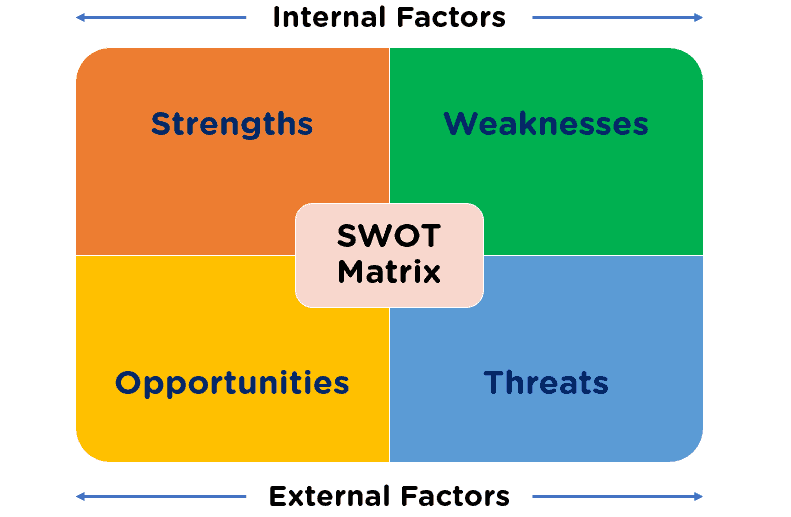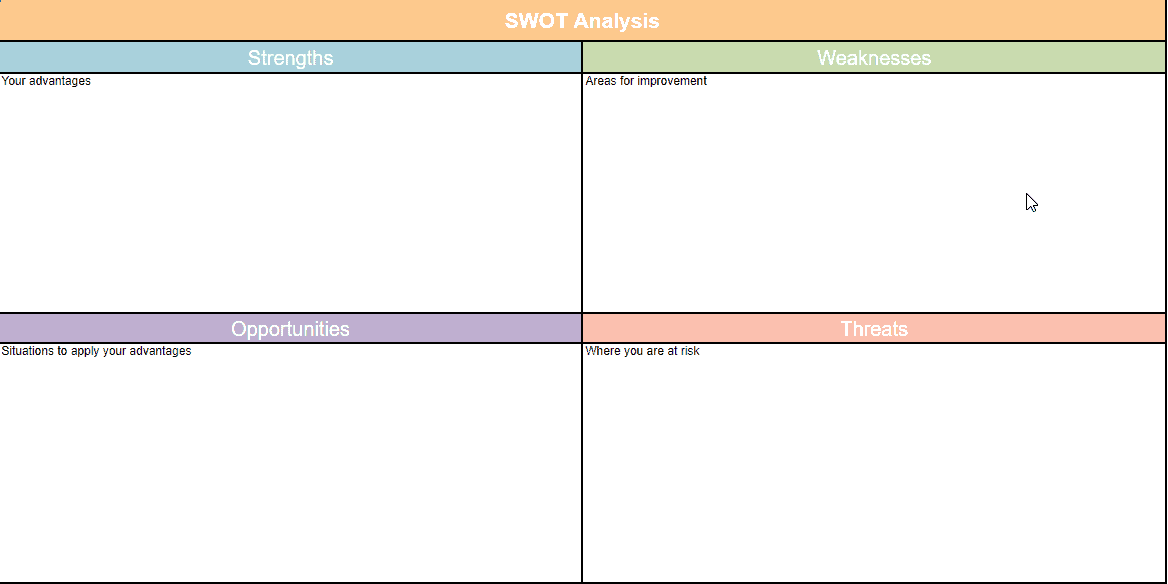When launching a startup, it is important to assess its potential and development prospects, highlight the main movement vectors, and predict the results. Marketing tools help with this process, particularly the SWOT analysis method, often used by the largest international TOP companies for strategic planning. Thanks to the SWOT analysis template, it is possible to evaluate global projects and local products without using complex tools.
It is necessary to conduct research at the first stage, before the start of the process of development and implementation of the project. In the following, we will provide a SWOT analysis template and explain its use in business.
What is a SWOT analysis?

SWOT is an abbreviation that consists of the following elements:
- Strengths – what are the advantages over competitors?
- Weaknesses – which actions were implemented poorly?
- Opportunities – what can be improved?
- Threats – what can prevent the process from being successful?
The SWOT analysis includes all four factors, allowing for high-quality strategic planning. As a result, the business gains a realistic view of the company’s development prospects in a particular industry based on internal and external evaluation factors.
With the help of a SWOT analysis template, you can find out what exactly the company does best, how far it lags or surpasses its competitors, and what emphasis needs to be placed on its online marketing strategy. Sometimes, in the analysis process, entrepreneurs decide to change their activities or choose a narrower specialization. However, to get accurate data, you need to avoid clichés and preconceived beliefs instead of focusing on objective information. Only then will you get transparent and high-quality results.
For SWOT analysis to be effective, it is necessary to provide realistic data, ideally with graphs and numbers. This is the most effective way to determine the current state and trends affecting the planning of activities.
Why is SWOT Analysis Important?
A SWOT analysis is used to create a roadmap. However, many startups ignore this opportunity – which is a serious mistake.
SWOT analysis is extremely important because it allows you to:
- Understand and measure the current performance of a startup and its best features.
- Use strengths to prove your value to the client.
- Minimize bugs and errors while taking care to remove future obstacles.
- Create an effective marketing plan tailored to market processes. You can choose 1-2 targeted online marketing channels – for example, SEO and Linkedin.
- Work out internal and external factors that can affect the business long-term. To do this, you should add sections to your site that explain why a customer should buy from you or create an account on your SaaS.
The analysis must be carried out not only at the start-up stage but also over the course of the company’s work. This ensures accurate tracking of the development dynamics, protecting vulnerable areas, and maintaining the company’s competitiveness and its individual products, goods, or services. Usually, SWOT analysis is performed by internal departments of the company. Still, in case of problems with critical thinking, the procedure can be entrusted to third-party organizations that will do a full audit.
Key Components of a SWOT Analysis

Let’s take a closer look at the four key components of SWOT analysis for other types of business:
- S – you need to identify your business’s strengths and prioritize them. For example, out of ten car washes in the city, only you use the latest equipment and high-quality cleaners, and you always have orderly lines or no queues – there are definite advantages that should be emphasized.
- W – problems sometimes arise from weaknesses if management is unwilling to admit them, so you need to make an objective assessment. In the example of a car wash, this may be the distance from major highways or unmotivated staff. Weaknesses need to be overcome, such as finding a better location or hiring new employees.
- O – unrealized business promotion opportunities can be a big loss. For example, you can ask customers to leave reviews, offer them free branded stickers, or provide special benefits to regular customers.
- T – threats must be calculated in advance in order to minimize their impact later. You will not be able to influence the opening of another car wash nearby or their use of better equipment. However, you can track trends and offer potential customers additional services that competitors do not have.
Sometimes the abbreviation USED is used, which is defined as:
- Use – use of strengths
- Stop – stopping weaknesses
- Exploit – the possibility of exploitation
- Defend – protection from threats
In any case, the four main criteria for analysis remain unchanged.
Types of SWOT Analysis Templates
Within the framework of a SWOT analysis, there are different typologies and approaches to building categories, but usually, three templates are distinguished:
- Classical. Assumes the division of all four components into separate columns or sectors with the possibility of supplementing and expanding each category. It is typically used during a brainstorming session or meeting with company officials.
- Final. A better quality template allows you to thoroughly analyze the current situation, market position, and available resources. To create it, use special analytical questions to assess all aspects of an activity.
- Distinctive. Aimed at identifying internal and external factors, which are sometimes combined or interrelated. Here you can create new categories – for example, “strengths – threats,” “weaknesses – opportunities,” to further work with them in a more narrow mindset.
Thus, the classic SWOT analysis template will help determine the main points of the strategy, the final one is necessary to form an action plan, and the distinctive one helps study the business environment while highlighting internal and external influential factors.
How Do You Use a SWOT Analysis Template?
Despite a rather primitive scheme and a visually simple technique, SWOT analysis is a complex procedure that requires considering internal and external factors. Only in this way can you maximize the potential of your business. In addition, the resulting SWOT analysis results can be added to a marketing or business plan as part of a visual demonstration.
One of the main difficulties is finding the starting points. As part of this task, it can be challenging not to go too deeply into problems that cannot be corrected. Sometimes the opposite situation is observed – energy is spent fixing little things that are insignificant within the company. Therefore, it is important to determine the overall goal to be achieved with the help of the SWOT template before starting the analysis.
Within the company, this can be the achievement of a certain profit margin or the occupation of a market segment. At the same time, it is better to narrow down the period, such as analyzing the data for the last year. Then follow the SWOT criteria by studying the following topics:
- Clients
- Competitors
- Market share
- Price policy
- Customer retention methods
- Suppliers
- Reputation
All of these areas affect the growth of the company.
Strengths, weaknesses, opportunities, and threats should be highlighted in each topic, following the traditional SWOT pattern. Then, immediately enter information into a spreadsheet, presentation, or Google document for quick and convenient use later.
SWOT Analysis: How to Act Upon Your Research
Having a SWOT analysis template in hand and completing your research, you need to turn it into a working strategy. This is the desired result.
First, you need to assess the strengths and think about how they can be used as a key for realizing potential opportunities. Also, look at the threats to the market and try to develop a strategy to minimize them using those same strengths.
Now that you have a clear list of actions grab your calendar and set up goals to achieve. Typically, the plan is drawn up in quarters or months by breaking the individual goals into components. Additionally, analyze how external opportunities will help in the fight to reduce the influence of internal weaknesses.
As a result, you should see how the product will develop, its obstacles, and facilitate promising growth.
SWOT Analysis Best Practices
There are many SWOT analysis practices; one of the most interesting is adding competitive analysis. In addition to the activities described above, you analyze your competitors and your superiority or lag behind them. Based on this analysis, a more detailed plan is developed and revised over time – taking into account competing companies’ dynamics, actions, and analytical forecasts.
To increase the productivity of the analysis, it is necessary to supplement it with digital intelligence, which provides necessary indicators in real-time. Be sure to look at the gap between positive and negative factors, assess their severity and possible risks, and take into account regional characteristics if you and your competitors work in different conditions.
SWOT Analysis Template From Plerdy

Having a working SWOT analysis template in front of your eyes will better structure your research. An example from Plerdy can help you navigate the features of the analysis – especially since it uses a standard structure consisting of the four SWOT sectors.
For example, in the case of a small digital agency, the list will be as follows:
- Strengths (advantages of the company) – a close-knit team, a clear distribution of responsibilities, teamwork.
- Weaknesses (areas for improvement) – work with large projects, staff development, high prices (due to the small amount of work).
- Opportunities (situations for applying strengths) – quick project execution, high-quality work results, a high level of creativity, the absence of conflicts and disputes affecting activities.
- Threats (company risks) – the emergence of competitors with low prices for products or services with higher efficiency, unforeseen situations with employees (maternity leave, injury, dismissal).
Naturally, within the framework of this analysis, Plerdy considers many more criteria of the company’s performance. This is just an example of how the assessment procedure can occur and what the management might conclude.
Conclusion
SWOT analysis is the most important procedure for a company because it can help identify strengths, weaknesses, opportunities, and potential threats. Continual use of SWOT analysis helps improve the team’s competitiveness, reduces the number of disadvantages, and prevents the development of negative factors. Thanks to effective management based on internal and external processes, the company will gain a stronger position in the market.
